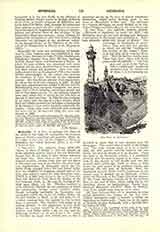

Bethsaida.—I. A CITY, or perhaps two cities, on the shore of the Lake of Genesareth, the frequent scene of Christ’s preaching and miracles (Matt., xi, 21; Luke, x, 13).—II., in the Vulgate, a Pool in Jerusalem, also called Bethesda (John, v, 2).—III. A TITULAR SEE.
I. THE CITY. (Gr. b?thsaida; Aram. BYT TSYDA, “house, or place, of fishing”.) The old writers, up to the sixteenth century, knew of but one Bethsaida, though they do not seem to have always indicated the same site. Since then it has been a much debated question whether there were not two places of this name: one east of the Jordan; the other west, near Capharnaum. A Bethsaida, which the Tetrarch Philip enlarged into a city and named Julias, after the daughter of Augustus, existed east of the river, near where it enters the lake (Josephus, Ant., XVIII, ii, 1; Bell. Jud., II, ix, 1; III, x, 7; Vita, 72). Near this Bethsaida took place the feeding of the five thousand (Luke, ix, 10) and the healing of the blind man (Mark, viii, 22). Whether another is to be admitted, depends on two questions on which the controversy mainly turns: whether Julias, though belonging politically to Gaulonitis, was comprised within the limits of Galilee (John, xii, 21) and whether, in Mark, vi, 45, and John, vi, 17, a direct crossing from the eastern to the western shore is intended. The negative view seems to be gaining ground. In the supposition of two Bethsaidas, the western would be the home of Peter, Andrew, and Philip (John, i, 44; xii, 21), and the Bethsaida of Matt., xi, 21 and Luke, x, 13. Julias is identified by many with et-Tell; but, as this is somewhat too far up the river to answer Josephus’s description, others prefer El-Araj, close to the shore, or Mes`adiyeh farther east. The partisans of a western Bethsaida are much divided on its site. `Ainet-Tabigha and Khan Minyeh are most favored.
I. THE POOL. (Gr. B?thsaida, b?thesda, b?thzatha.) Bethesda is supported by most Gr. MSS., still Bethzatha may be the true reading and Bethesda a corruption, as Bethsaida most probably is. Bethesda probably = BYT HSDA (House of Mercy). The etymology of Bethzatha is uncertain.] This pool had five porches in which the sick lay “waiting for the moving of the waters” (John, v, 3) and most likely steps led down to it. Here the Savior cured a man “that had been eight and thirty years under his infirmity”. The Vulgate and most of the Fathers call it a “sheep pool” (probatike, probatica) but the Greek text of John, v, 2, is commonly understood to mean that it was situated near the sheep gate. This would place it north of the temple area. The early writers speak of it as a double pool, the fifth portico running between the two basins, but give no details as to its location. From the sixth to the thirteenth century, it is mentioned as being near the present church of St. Anne. Just west of this church an old double pool was discovered some years ago, which is, there is little doubt, the pool spoken of by medieval writers, and probably the old pool of Bethesda. Since the fourteenth century Birket Isra’in, northeast of the temple area, is pointed out as Bethesda. Others prefer the Fountain of the Virgin (Ain Sitti Mariam, or `Ain Umm ed-Derej) because of its intermittent flow; or the pool of Siloe, which, being fed by the preceding, shares its intermittence. Lastly, some advocate Hammam esh-Shifa (Bath of Health), west of the temple area, because of its name.
II. THE TITULAR SEE.—It is uncertain at what period Bethsaida, the former of the two cities (Julias) mentioned under I, became a titular see depending on Scythopolis. There was in the region of Nineveh another Bethsaida, with a Jacobite titular bishop in 1278.
F. BECHTEL

